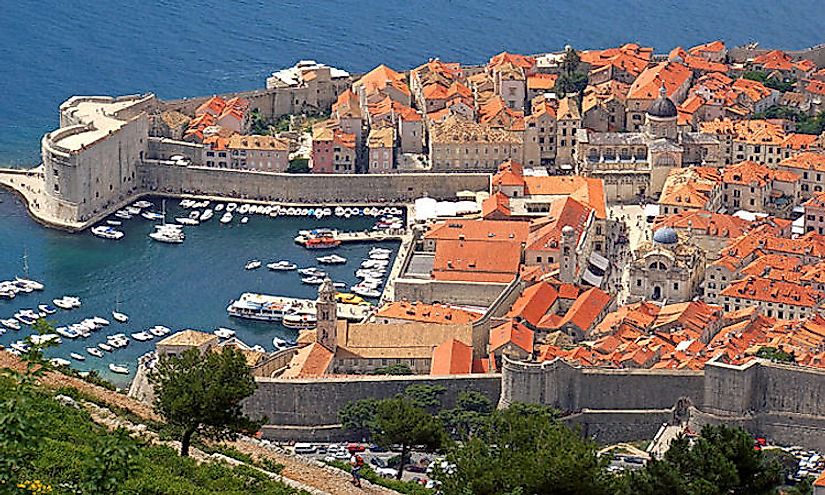UNESCO World Heritage Sites In Croatia

Croatia is a country in Southeast Europe bordering Bosnia and Herzegovina, Hungary, Montenegro, Serbia, and Slovenia. The sites in Croatia include old cities, churches, palaces and graveyards along with the natural beauty of Plitvice. The country boasts of rich cultural and historical heritage. Croatia is home to eight World Heritage sites, seven of which are cultural sites while one is a natural site.
UNESCO World Heritage Sites In Croatia
Dubrovnik Old City
The Dubrovnik Old City became a cultural UNESCO World Heritage Site in 1979. Dubrovnik was a medieval maritime power, suitably located on the Dalmatian coast. From the 13th century, the city rose to prominence, particularly in the 15th and 16th centuries when it amassed great wealth. Numerous churches, palaces, and monasteries in the city built in Gothic, Renaissance, and Baroque styles attest to the city’s former glory. Nearly all of the old city’s walls are intact, and it remains one of the best preserved old cities in the world. Dubrovnik has however had its share of threats, starting with a 1667 earthquake. The city also experienced damage through shelling in the armed conflicts of the 1990s. Collaborations between UNESCO and the Croatian government have facilitated restoration of the old city’s heritage. The city was removed from the endangered list due to the success of the restoration programs and is a popular tourist destination in Croatia.
The Historic City Of Trogir
The Historic City of Trogir was inscribed as a UNESCO world cultural heritage site in 1997. Trogir is a medieval town which prides in numerous Baroque and Renaissance buildings and majestic Romanesque Churches. Among its attractions are the monumental Cathedral of St. Lovro, Kamerlengo Fortress, and the Cipiko Palace. The city is culturally significant since it has managed to preserve its medieval layout and architecture with minimal urban interference. The city of Trogir was established as a trading settlement by the Greeks in the 3rd century and thrived under the Romans. The city is mostly intact and well preserved, and it is one of the renowned old cities of Europe.
Euphrasian Basilica Episcopal Complex in Historic Poreč
The Euphrasian Basilica Episcopal Complex was inscribed as cultural World Heritage Site in 1997. The complex comprises of a church, Episcopal palace, baptistery, chapel and an atrium. Built in the 4th century, the complex is regarded as one of the founding centers of Christianity. The complex derives its cultural and historical significance from being the most intact complex of its kind in the world. The complex is one of the best representations of medieval Byzantine architecture. Being a heritage site and a major tourist destination, the site is well preserved and managed.
Saint James Cathedral In Šibenik
The Saint James Cathedral in Šibenik was listed as a cultural heritage site in 2000. Situated on the Dalmatian coast, the Cathedral was built from 1431 to 1535. The Cathedral is significant since it represents an architectural exchange between Northern Italy, Dalmatia, and Tuscany. The Cathedral represents both Gothic and Renaissance styles and is renowned as the largest church in the world completely built with stone, without wood or brick support. Notable on the Cathedral is the frieze of 71 heads with various facial expressions on the rear exterior walls. The Cathedral’s unparalleled beauty and attracts thousands of tourists annually.
Top Tourist Destination In Europe
Other UNESCO World Heritage Sites in Croatia and the year they were inscribed are the Palace of Diocletian and the Split Historical Complex (1979; cultural); Plitvice Lakes National Park (1979; natural); Stari Grad Plain (2008; cultural) and Stećci Medieval Tombstones Graveyards (2016; cultural). Croatia’s cultural and heritage sites have established the country as a top tourist destination in Europe. Huge crowds are witnessed visiting the various sites throughout the year.
UNESCO World Heritage Sites In Croatia
| UNESCO World Heritage Sites in Croatia | Year of Inscription; Type |
| Dubrovnik Old City | 1979; Cultural |
| Euphrasian Basilica Episcopal Complex in Historic Poreč | 1997; Cultural |
| Historic City of Trogir | 1997; Cultural |
| Palace of Diocletian and the Split Historical Complex | 1979; Cultural |
| Plitvice Lakes National Park | 1979; Natural |
| Saint James Cathedral in Šibenik | 2000; Cultural |
| Stari Grad Plain | 2008; Cultural |
| Stećci Medieval Tombstones Graveyards | 2016; Cultural |







